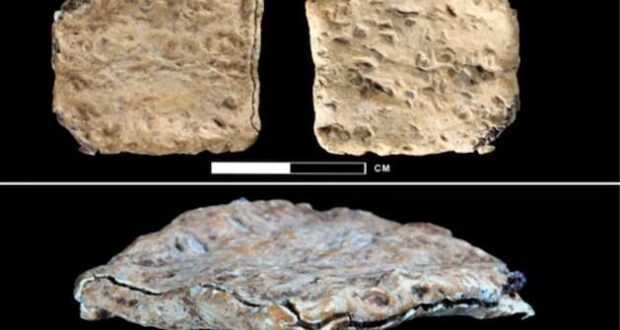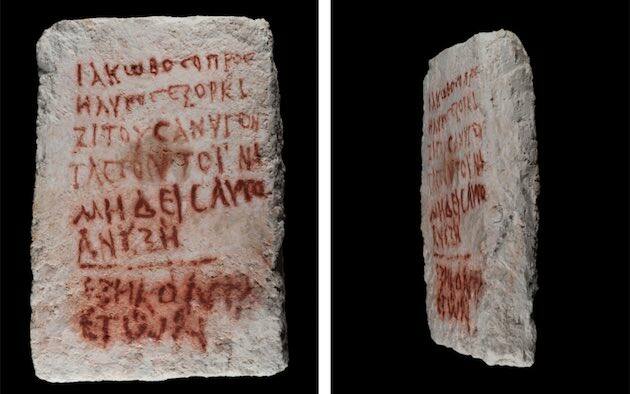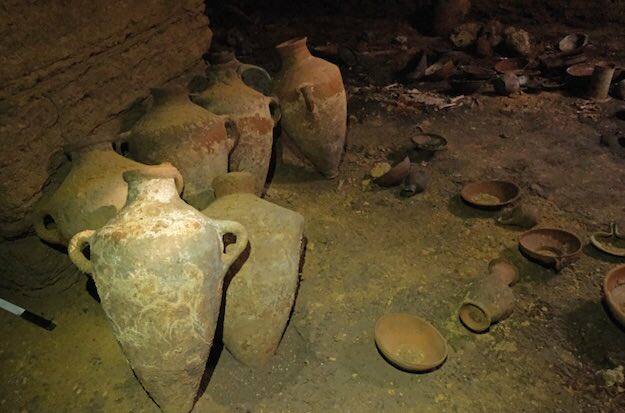What are the biggest biblical archaeological discoveries in 2022? Dozens of extraordinary finds were announced over the last 12 months that reveal insights into scripture and affirm dates, places and events in the Bible. In some cases, leading scientific organizations used the discoveries to learn more about the earth by putting artifacts through rigorous scientific examination.
Bryan Windle, writing for Bible Archaeological Report, has listed the Top 10 discoveries. He uses specific criteria for discoveries to make the Top 10.
- The discoveries must be related to places, events or people in Scripture or to the composition of Scipture.
- They must be actual discoveries that took place in the calendar year, as opposed to announcements of previous discoveries.
- A discovery must have been publicized through an official announcement by a Ministry of Antiquities or from a licensed archaeological dig with the expectation that a peer-reviewed article will follow.
Here are the top ten discoveries in Biblical archaeology in 2022.
10. “Proselyte” Inscription Unearthed in Cemetery at Beit Shearim (June 2022)
An 1800 year-old grave marker from “Jacob the Proselyte” was discovered in the prestigious cemetery at Beit Shearim. The inscription, written in red ink, reads, “Jacob (Iokobos) the convert [proselyte] swears upon himself that any who open this grave will be cursed.” This is followed by a thick red line and a second inscription. written by another, which reads, “Aged 60.” Scholars believe Jacob composed his own grave marker prior to death, with the secondary “Aged 60” inscription being added after he died. Over 300 inscriptions in four languages have been discovered at the Beit Shearim necropolis; this is the first that unequivocally states that a convert is buried there. In the New Testament era and subsequent centuries there appear to have been two groups of converts to Judaism: proselytes, gentiles who became full-converts by adopting all of the commandments, and God-fearers, who followed some Jewish rites but were likely not circumcised. Both proselytes (Mt. 23:15) and God-fearers (Acts 13:16) are mentioned in the New Testament.
9. Intact Tomb from the 13th Century BC Discovered in Israel (September 2022)
An intact tomb from the Late Bronze Age was discovered in the Palmachim Beach National Park south of Tel Aviv. The burial cave was revealed when a tractor dislodged a rock during work being done by Israel’s Nature and Parks Authority. Archaeologists from the Israel Antiquities Authority (IAA) immediately descended 2.5 meters (8 ft.) into the cave and found it filled with various pottery vessels, including bowls, cooking pots, jugs, and oil lamps. According to Eli Yannai of the IAA, these vessels date to the LB IIB period (13th century BC). A video of the discovery went viral, and appears to show multiple skeletons in the corner of the tomb. As the news broke, and before the tomb could be resealed, a number of items were stolen from the cave. The discovery is significant in that it will help scholars understand burial customs in Israel during the period of the Judges.
JOIN US ON A TOUR OF ISRAEL! LEARN MORE
8. Linear Elamite Script Finally Deciphered (September 2022)
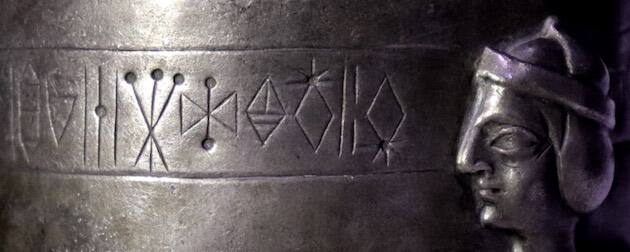
The Linear Elamite script on the Marv Dasht vessel dating to the 21st century BC. Photo: The National Museum of Iran
A group of epigraphers claimed to have deciphered the Linear Elamite script, a system of writing used in the ancient kingdom of Elam (located in modern-day southern Iran) from 2300 to 1880 BC. François Desset, Kambiz Tabibzadeh, Matthieu Kervran, Gian Pietro Basello, and Gianni Marchesi recently published their research in the journal Zeitschrift für Assyriologie und Vorderasiatische Archäologie. Linear Elamite was first discovered in 1903 on monuments excavated at Susa. The real key to deciphering Linear Elamite was the publication in 2018 of eight silver beakers from Tal-e Malyan that bore the script. These beakers featured Elamite royal inscriptions from various kings who reigned from 2000 to 1880 BC.
The authors of the study recognized that these inscriptions shared titles, formulas, and similar phraseology with later Elamite text written in cuneiform. The comparison of a single language written in two different scripts allowed these scholars to decipher Linear Elamite; they caution, however, that there is much work to do since knowledge of Elamite grammar and vocabulary is still in its infancy. This development is of interest to the field of biblical studies: the kingdom of Elam is named as one of the nations that developed its own language after the Tower of Babel (Gn 10:22, 10:31, 11:1–9), and Kedorlaomer (the Hebrew version of the Elamite name Kudur-Lagamar) is named as one of the kings involved in the Battle of Siddim (Gn 14:1–16). According to a literal, straightforward understanding of biblical chronology, both of these events would have occurred within the period in which Linear Elamite was in use.
7. 2100-Year-Old Farming Settlement Discovered in Galilee (April 2022)
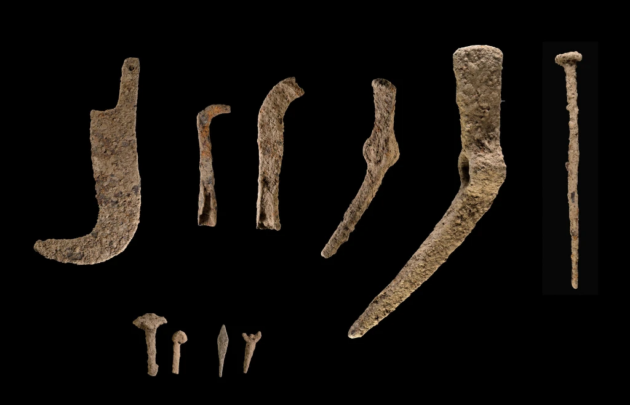
Iron Tools discovered at a Hellenistic-era farmstead in the Galilee. Photo: Dafna Gazit/Israel Antiquities Authority
A salvage excavation at Horbat Asad in the eastern Galilee unearthed a Hellenistic/Hasmonean-era farmstead and an earlier, Iron Age agricultural settlement. The Hellenistic/Hasmonean farmstead appears to have been suddenly abandoned, with iron tools and loom-weights discovered as if they’d been left behind. Coins were also found which, when cleaned, may provide a more specific chronology of the site. These are the first remains from this era discovered in the Galilee. According to the lead excavator, “It is a very important and valuable site to teach us about the spread of the Hasmonean Empire and daily life in the Hellenistic period.” Archaeologists also uncovered the remains of a substantial agricultural settlement from the 10th century BC. Loom weights indicated herds of sheep and goats were kept, and cooking pots helped the excavators date this layer at the site.
6. New Analysis Dates Shroud of Turin to the First Century (April 2022)
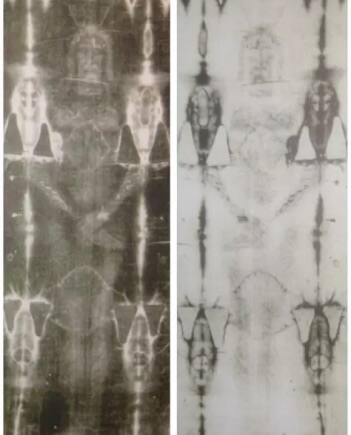
The negative and positive images of the Shroud of Turin. Photo: אסף.צ / Wikimedia Commons / Public Domain
A new study overseen by Dr. Liberato de Caro of Italy’s Institute of Crystallography of the National Research Council, in Bari concluded that the Shroud of Turin dates to the first century. In a report published on the website of Italy’s Department of Chemical Sciences and Materials Technologies, de Caro outlined the “Wide-Angle X-ray Scattering” or WAXS method they used, which measures the structural degradation due to natural aging of the cellulose that makes up the fibers of the linen threads. This process, which is non-destructive, was used on a variety of historical textiles which have well-documented ages, and then compared to the Shroud of Turin; the best match was with a piece of fabric from ca. AD 55-74 known to have come from the siege of Masada in Israel. The new dating contradicts the 1988 carbon-14 test of fabric threads from the shroud, which dated the relic to the Middle Ages. Critics have long-pointed out that that test was flawed, as it came from an area of the fabric that was repaired in the Middle Ages. The new study also notes that ancient textiles can become contaminated with substances over time that could distort carbon-14 results. The new findings, if accurate, suggest that the fabric of the Shroud of Turin originated around the time of Christ.
5. Mosaic Inscription Unearthed at El-Araj that Refers to Peter (August 2022)
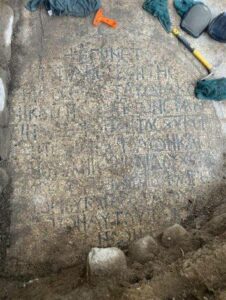
This mosaic inscription, discovered in the remains of a Byzantine church at El-Araj, references the “Head and Leader of the Heavenly Messengers,” a phrase used by Byzantine Christians to refer to the Apostle Peter. Photo: El Araj Excavation Project
The El-Araj Excavation Project announced the discovery of a mosaic inscription referring to Peter in a Byzantine church at the site. El-Araj is one of two sites (the other being et-Tell) that claims to be biblical town of Bethsaida, which later became a city and was renamed Julias. Dig Director, Mordechai Aviam, from the Kinneret Institute for Galilee Archeology at Kinneret College on the Sea of Galilee, and Academic Director, Steven Notley from Nyack College believe the Byazntine structure they have unearthed is the church at Bethsaida described by the pilgrim Willibald in A.D. 724that was said to have been built over the home of Peter and Andrew. The recently-discovered mosaic inscription begins with the phrase, “Constantinos, the servant of the Messiah,” assumed to be the donor and references the “Head and Leader of the Heavenly Messengers,” a phrase used by Byzantine Christians to refer to the Apostle Peter. The researchers at El-Araj believe this discovery indicates the church was dedicated to Peter and that this is further evidence that El-Araj is the site of biblical Bethsaida, the hometown of Peter, Andrew and Philip (John 1:44) and the village that Jesus actively ministered in (Matt. 11:21).
4. New Study Affirms Biblical Battles Using Earth’s Magnetic Field (October 2022)
A new paleomagnetic study published in the Proceedings of the National Academy of Sciences (PNAS) helped to clarify the dates of destruction at various Iron Age sites in Israel. The study, entitled, “Reconstructing biblical military campaigns using geomagnetic field data” was authored by Yoav Vaknin, his PhD advisors, and numerous archaeologists, including Amihai Mazar, Aren Maier, Yosef Garfinkel, Rami Arav, Avraham Faust, Ron Tappy, and Seymour Gitin. Paleomagnetics studies the ferromagnetic particles in objects that have been heated at high temperatures, such as in a pottery kiln or in a layer destroyed by fire, to determine the signature of the magnetic field at the time of heating. The earth’s magnetosphere fluctuates, and researchers have spent the past decade reconstructing the earth’s magnetic field by analyzing hundreds of known, datable objects.
In their new study, the authors used the data from 21 destruction layers at 17 sites in Israel to determine when the settlements were destroyed. They claim that their research has helped to settle the debate around whether Beth She’an was destroyed by Pharaoh Shishak (Sheshonq I) in the tenth century BC or Hazael, the king of Damascus in the ninth century BC. The paleomagnetic data from burnt bricks in destroyed buildings at Beth She’an does not align with the time of Hazael, but is compatible with the time of Shishak. Another example comes from Beth Shemesh, which the paleomagnetic data suggests was destroyed at the beginning of the 8th century BC. This does not correspond to any known foreign invasion, but does lend support to the biblical text, which describes a battle between Judah and Israel around this time: “So Jehoash king of Israel went up, and he and Amaziah king of Judah faced one another in battle at Beth-Shemesh, which belongs to Judah. And Judah was defeated by Israel, and every man fled to his home” (2 Kings 14:11-12). Vaknin believes paleomagnetic data can be used to complement radiocarbon data and ceramic typology to more accurately date artifacts and sites in Israel, particularly during the Iron Age.
3. Ivory Lice Comb Contains Early Canaanite Inscription (November 2022)
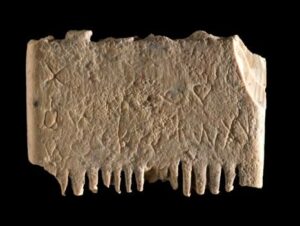
An ivory lice comb discovered at Lachish bearing an early Canaanite inscription. Photo: Dafna Gazit / Israel Antiquities Authority
Yosef Garfinkel and Michael G. Hasel announced the discovery of an ivory lice comb bearing an early Canaanite inscription. The ivory comb, which was discovered in 2016 and is 3,700 years old, measures approximately 3.5 × 2.5 cm in size. It once had teeth on both sides, but they were broken off sometime in the past. The inscription consists of a sentence of seven words, made up of 17 letters in early pictographic style, and expresses a desire for the comb to be effective. It reads, “May this tusk root out the lice of the hai[r and the] beard.” Garfinkel and Hasel are two of the authors of a study on the artifact published in the Jerusalem Journal of Archaeology. In the article, it is asserted the inscription “for the first time provide[s] us with a complete reliable sentence in a Canaanite dialect, written in the Canaanite script.”
2. Ancient Ivory Inlays Discovered in Jerusalem (September 2022)
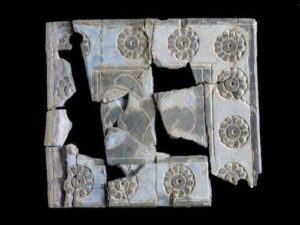
Ivory pieces reassembled into a panel that likely adorned furniture in the home of Judahite elites or royalty in the Iron Age. Photo: Dafna Gazit / Israel Antiquities Authority
Archaeologists in Jerusalem unearthed a trove of 1,500 ivory fragments dating to the First Temple era. The artifacts were excavated at the Givati Parking Lot but only came to light when material was wet-sifted at the Emek Tzurim National Park. The ivory pieces themselves were carved with geometric shapes, lotus flowers, and rosettes and were likely inlays that decorated wooden furniture. Conservator Orna Cohen and Ilan Naor meticulously studied and reassembled hundreds of fragments and determined they were the remains of at least 12 square plaques, each measuring 5 cm by 5 cm. The ivory inlays were excavated in a monumental building, possibly the home of Jewish elites or royalty, that was destroyed by the Babylonians in the sixth century BC. Ivory is often associated with royalty and wealth and has been found in other ancient capital cities, such as Samaria and Nimrud. This discovery is evidence of the biblical description of the prominence of Jerusalem in the Iron Age. These ivories also illustrate what other ivory-inlaid furniture mentioned in the Bible may have looked like (i.e., Solomon’s ivory throne in 1 Kings 10:18 and the ivory-inlaid beds mentioned in Amos 6:4). Moreover, the discovery highlights the importance of wet sifting, a process that ABR has been on the forefront of implementing in their excavations.
NOTE: The date of the fall of Jerusalem is a matter of debate, with many holding to 586 BC as the date of the destruction of the city. However, ABR associate and biblical chronologist Roger Young has presented evidence suggesting that Jerusalem actually fell during the summer of 587 BC (see link below).
1. Oldest Proto-Alphabetic Inscription in Israel Contains the Name of YHWH (March 2022)
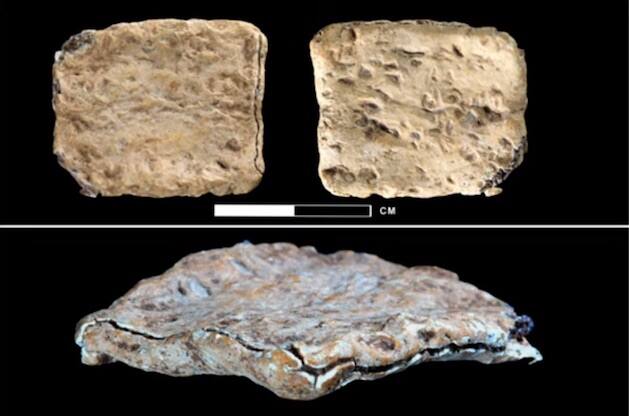
This lead curse was discovered in wet-sifting of material from Adam Zertal’s excavations on Mt. Ebal. Photo Courtesy of Scott Stripling
The Associates for Biblical Research (ABR) announced the discovery of a curse tablet bearing an ancient Hebrew inscription which was recovered in the dump piles from Adam Zertal’s excavations on Mt. Ebal. The small, folded lead tablet was discovered in December 2019 through the process of wet-sifting during the Mt. Ebal Dump Salvage project, led by Dr. Scott Stripling. A team of scholars, including Dr. Stripling and four 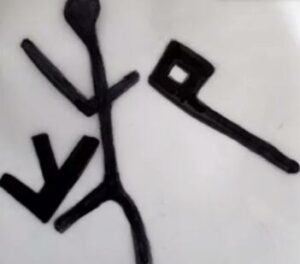 scientists from the Academy of Sciences of the Czech Republic, as well as two epigraphers – Pieter Gert van der Veen of Johannes Gutenberg-Universität Mainz and Gershon Galil of the University of Haifa – used advanced tomographic scans to recover the hidden text. The recently deciphered the proto-alphabetic inscription reads:
scientists from the Academy of Sciences of the Czech Republic, as well as two epigraphers – Pieter Gert van der Veen of Johannes Gutenberg-Universität Mainz and Gershon Galil of the University of Haifa – used advanced tomographic scans to recover the hidden text. The recently deciphered the proto-alphabetic inscription reads:
The divine name YHW from Mt. Ebal in proto-alphabetic script. Drawing: Gershon Galil
Cursed, cursed, cursed – cursed by the God YHW.
You will die cursed.
Cursed you will surely die.
Cursed by YHW – cursed, cursed, cursed.
From 1982–1989 Adam Zertal excavated a rectangular altar, dating to the 13th century BC, on Mt. Ebal. Beneath this structure and at the exact geometric center, was a round altar, which may date to the Late Bronze Age, the time of Joshua. The biblical text describes Joshua building an altar on Mt. Ebal (Josh. 8:30) and it being the mountain from which curses were pronounced (Deut. 27:13-26).
If this artifact does indeed date to the Late Bronze Age, is an important discovery! Inscriptions from ancient Israel are rare, and this one bears the name YHWH, the name by which God revealed Himself to Moses (Ex. 3:14). It is the oldest inscription containing the divine name YHW yet discovered in ancient Israel. Moreover, the lead curse tablet has been dated to the Late Bronze Age, and may be connected with the renewal of the covenant on Mt. Ebal (Josh. 8:30-35). It is also further evidence that the Bible was written at the time it purports to be, and not centuries later as those who hold to the documentary hypothesis assert.
An academic, peer-reviewed article is in process and will be published early in 2023..
Conclusion
Each year I sift through over 200 news reports related to biblical archaeology. I do this both for my own blog and for the Associates for Biblical Research with whom I am a Staff Researcher and Writer. Each week I write a Breaking News update for their website. You can stay up-to-date on the latest BREAKING NEWS in biblical archaeology each week here: https://biblearchaeology.org/current-events-list
2022 was another exciting year in the world of biblical archaeology. These ten discoveries were among the many made in the past year which illuminate and affirm details in the Bible and help us better understand the biblical world. I look forward to seeing which discoveries will be made in the coming year.
You can read his previous Top 10 lists here: 2021, 2020, 2019, 2018, 2017, and 2016, as well as the Top Ten Discoveries of the Decade (2010-2019), and Top Ten Discoveries of All-Time Relating to Both the Old and New Testaments.
 Metro Voice News Celebrating Faith, Family & Community
Metro Voice News Celebrating Faith, Family & Community

